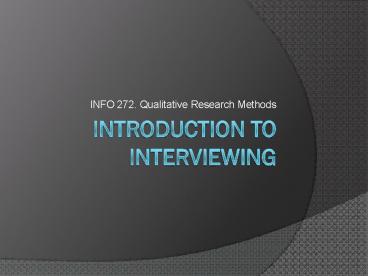Introduction to Interviewing - PowerPoint PPT Presentation
Title:
Introduction to Interviewing
Description:
Title: introduction Last modified by: Jenna Burrell Created Date: 8/16/2006 12:00:00 AM Document presentation format: On-screen Show (4:3) Other titles – PowerPoint PPT presentation
Number of Views:185
Avg rating:3.0/5.0
Title: Introduction to Interviewing
1
Introduction to Interviewing
- INFO 272. Qualitative Research Methods
2
Outline
- What is Qualitative Interviewing?
- Underlying theory
- Interview techniques
3
Suchman and Jordans Critique
- Aspects of ordinary conversation
- Local control
- Question redesign
- Answer elaboration
- Detection and repair of misunderstandings
4
Qualitative Interviewing
to obtain descriptions of the life world of the
interviewee with respect to interpreting the
meaning of the described phenomena. pg. 5-6
Kvale
to gain a fine-textured understanding of
beliefs, attitudes, values and motivations in
relation to the behaviors of people in particular
social contexts. pg. 39 Bauer and Gaskell
5
Reasons to Conduct Qualitative Interviews
- Developing detailed description of an event
- Integrating multiple perspectives
- Learning how events are interpreted
- Bridging inter-subjectivities
- Identifying variables and framing hypotheses for
quantitative research - Learning from Strangers. Pg. 9-11
6
Keeping in Mind...
- an interview is a negotiation between interviewer
and interviewee (who exert reciprocal influence) - an Inter-View Kvale
- What is the underlying theory of social reality?
7
Keeping in Mind...
- when we understand knowledge as the social
justification of belief rather than as accuracy
of representation, conversation replaces
confrontation with nature. - the certainty of our knowledge is a matter of
conversation between persons, rather than a
matter of interaction with a nonhuman reality.
8
Mediation
- through memory
- through interviewees self-perception
- through interviewers perceptions
- the presence of the interviewers and others
- extreme cases teenagers/pre-teens, politicians
9
Advantages Disadvantages
- artificiality distance from event/experience
(remember Becker on the accuracy gained from
close observation)
- efficiency generate a large amount of material
on a specific topic in a short amount of time - getting at the internal world of meaning and
interpretation of individuals
10
Types
- individual depth interviews
- narrative interviews focusing on a specific
experience - expert interviews
- ethnographic interviews usually situated in
interviewees cultural milieu, often spontaneous
and informal - joint interviews and focus groups i.e. husband
and wife, family, household, co-workers, etc.
11
Interview Techniques
- Main goal get your interviewees to talk openly
and at length about a topic you have selected,
but in their own words and in relation to their
own experiences. - This involves developing and extending your
skills of conversation in a particular way
12
Interview Techniques
- Recalling Suchman and Jordan
- Give the interviewee as much control over the
conversation as possible - Allow interviewee to redesign the questions
- Allow/encourage interviewee to elaborate on
answers - Confirm and clarify responses
- Detect and repair misunderstandings
13
Interview Techniques
- what can go wrong?
- suspicion, evasion, stonewalling
- Interviewees who speak very little, or are
extremely talkative, or go way off-topic - speaking in generalities only, attempting to do
the analysis for you (let me tell you how people
use the Internet here)
14
Interview Techniques
- first things first explain yourself and your
expectations - establishing rapport
- topics the interviewee enjoys talking about
- commiserate, empathize, be human
15
Interview Techniques
- avoiding generalities
- ask for concrete examples, personal stories
- accessible questions with appropriate vocabulary
(i.e. dont use terms like discourse or
globalization) - quality concerns
- avoid leading questions dont you think...
isnt it true... - clarify and confirm
16
Interview Techniques
- encouraging verbosity
- avoid yes/no questions, ask questions that
require descriptive or narrative answers. - tell me about a time when you ...
- can you give me an example of...
- how would you describe...
- be quiet and wait
- ask follow up questions, allow interesting
tangents to develop
17
Interview Techniques
- discouraging verbosity
- politely interrupt
- throw them off guard with abrupt topic changes
18
Interview Techniques
- Probes
- D ...it got to a time where we had to come to
work on Sundays and I was going bad, this is
Internet, Ive got to be careful of myself. So,
and the Lord spoke to me in several ways. - J you said that you had to be careful with the
Internet, how so, what do you mean by that?
19
Interviewing in Other Cultures
- issues with language
- attitudes in that particular society/subculture
towards authority and the right to speak - ideas about and experience with research
practices - private information (age, weight, income)
- rapport and suspicion (of identity, of
methodology) - time and scheduling
20
Key Ideas to Remember
- explain yourself and gain permission
- ask open-ended questions in accessible language
- follow the interviewees lead, clarify and
confirm, detect and repair misunderstandings - use probes
21
Tuesday
- Discussing examples of good and bad interviews































